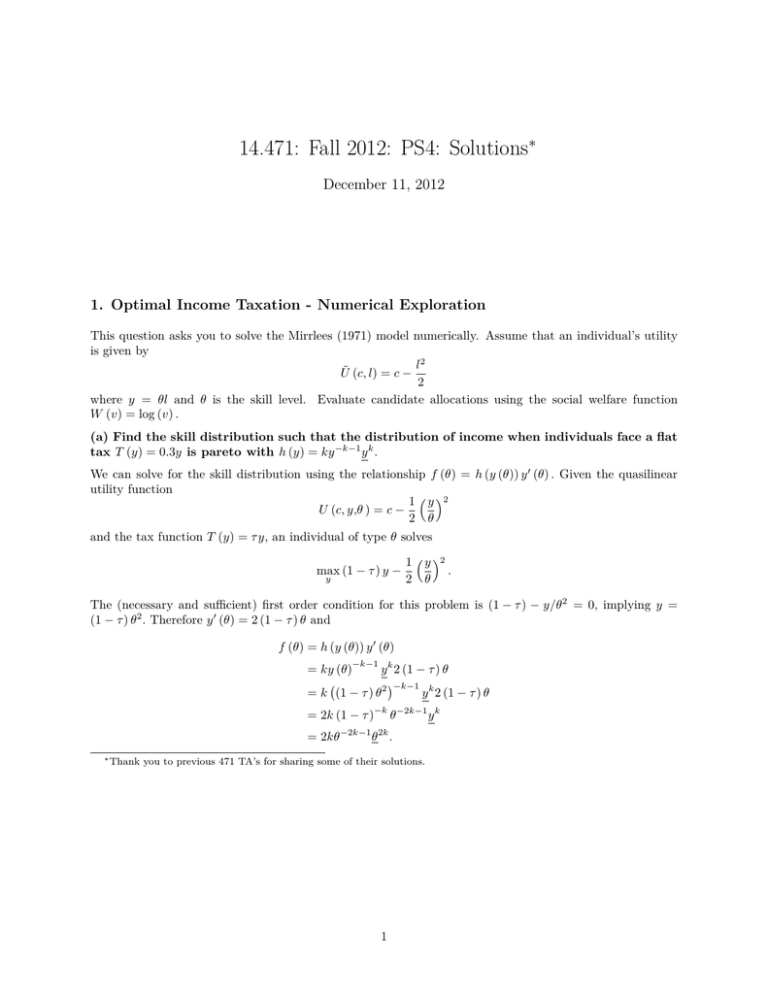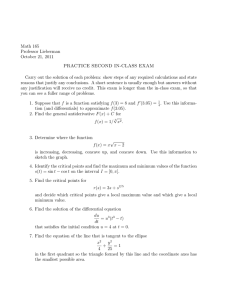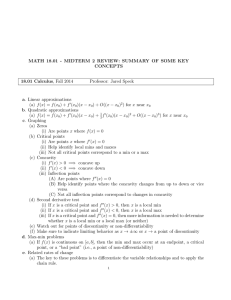14.471: Fall 2012: PS4: Solutions ∗ December 11, 2012 1.
advertisement

14.471: Fall 2012: PS4: Solutions∗ December 11, 2012 1. Optimal Income Taxation - Numerical Exploration This question asks you to solve the Mirrlees (1971) model numerically. Assume that an individual’s utility is given by l2 Ũ (c, l) = c − 2 where y = θl and θ is the skill level. Evaluate candidate allocations using the social welfare function W (v) = log (v) . (a) Find the skill distribution such that the distribution of income when individuals face a flat tax T (y) = 0.3y is pareto with h (y) = ky −k−1 y k . We can solve for the skill distribution using the relationship f (θ) = h (y (θ)) y � (θ) . Given the quasilinear utility function 1 � y �2 U (c, y,θ ) = c − 2 θ and the tax function T (y) = τ y, an individual of type θ solves max (1 − τ ) y − y 1 � y �2 . 2 θ The (necessary and sufficient) first order condition for this problem is (1 − τ ) − y/θ2 = 0, implying y = (1 − τ ) θ2 . Therefore y � (θ) = 2 (1 − τ ) θ and f (θ) = h (y (θ)) y � (θ) y k 2 (1 − τ ) θ = ky (θ) � �−k−1 k = k (1 − τ ) θ2 y 2 (1 − τ ) θ −k−1 = 2k (1 − τ ) −k θ−2k−1 y k = 2kθ−2k−1 θ2k . ∗ Thank you to previous 471 TA’s for sharing some of their solutions. 1 Integrating, F (θ) = ˆ θ ˆ θ f (θ) dθ θ = θ 2k (1 − τ ) −k θ−2k−1 y k dθ �θ � −k = − (1 − τ ) θ−2k y k = (1 − τ ) −k θ = 1 − (1 − τ ) −2k −k θ � (1 − τ ) θ2 θ−2k y k �k − (1 − τ ) −k θ−2k y k = 1 − θ−2k θ2k . (b) Solve for the optimum numerically ignoring the monotonicity condition. Use y = 2 and k = 4 and truncate your distribution at the top x percentile for some small x. Compare your results to Saez’s. Copied from the recitation notes, the problem is max v(θ),y(θ) ˆ θ ˆ θ W [v (θ)] f (θ) dθ θ s.t. θ � (y (θ) − e (v (θ) , y (θ) , θ)) f (θ) dθ ≥ 0 v (θ) = Uθ [e (v (θ) , y (θ) , θ) , y (θ) , θ] y (θ) nondecreasing. We ignore the monotonicity constraint. We form the Hamiltonian H = W [v (θ)] f (θ) + λ (y (θ) − e (v (θ) , y (θ) , θ)) f (θ) + η (θ) Uθ [e (v (θ) , y (θ) , θ) , y (θ) , θ] . The standard conditions are ∂H = 0 ⇒λf (1 − ey ) + η [Uθc ey + Uθy ] = 0 ∂y ∂H = −η � ⇒W � f − λev f + ηUθc ev = −η � . ∂v � � In addition, we have the transversality conditions η (θ) = η θ = 0. From W (v) = log (v) and U (c, y,θ ) = 2 c − (1/2) (y/θ) we obtain the following derivatives Uθ = 2y 1 y2 , Uθc = 0, Uθy = 3 , and W � = . 3 θ θ v Recalling the relationship v = U (e (v, y,θ ) , y, θ) , we have 1 = Uc ev and 0 = Uc ey + Uy . Therefore ev = 1 Uy y = 1 and ey = − = 2. Uc Uc θ Substituting into the equations for optimality of the control and state variables yields � � � y� 2y λf 1 − 2 + η 3 = 0 θ θ f − λf = −η � . v 2 Solving the first equation for y (θ) leads to y (θ) = and rewriting the equation for η � results in η � (θ) = λf (θ) θ3 λf (θ) θ − 2η (θ) � λ− 1 v (θ) � f (θ) . Lastly, substituting the value of y (θ) into the incentive constraint, � �2 y2 λf (θ) � v (θ) = Uθ [e (v (θ) , y (θ) , θ) , y (θ) , θ] = 3 = θ3 . λf (θ) θ − 2η (θ) θ Our problem then boils down to a two-dimensional system of ordinary differential equations in η (θ) and v (θ) . We solve using the following procedure: 1. Pick λ. 2. Pick v (θ) . 3. Solve the system of differential equations numerically using a shooting algorithm. � � 4. Check that η θ = 0. It probably won’t. Try step 2 again. 5. Check that the resource constraint is satisfied. It probably won’t be. Try step 1 again. 6. Check that y (θ) is nondecreasing. It should be. 7. Declare victory/go home. See the Matlab code posted on the website for details and results. Saez found interesting behavior in the pattern of marginal rates at moderate income ranges as a result of using the actual (and more complicated) income distribution. We obtain a simple hump-shaped pattern of marginal rates. We also obtain a zero marginal tax rate at the top as a result of our truncation. 2. Pareto-optimal income taxation This problem asks you to evaluate the Pareto Efficiency of a tax schedule. Assume the income elasticitity of labor supply is zero. Let �∗w denote the compensated elasticity of labor supply with respect to the real wage. Let the distribution of income generated by the current tax system be Pareto h(Y ) = k(Y )−k−1 Y k f or Y ≥ Y and k > 0 (a) Suppose there is a linear flat tax T (Y ) = T + τ Y with marginal tax rate τ and intercept T . Suppose �∗w does not vary across individuals (at all income levels). Note that this would be true if the utility function is U (c, Y,θ ) ≡ c − θY α . Starting from the general test for Pareto efficiency derive an inequality for τ , �∗w and k . Consider some empirically plausible values. The starting point is the following inequality from p. 10 of our lecture notes: τ (θ) d log (�∗w (y)) d log (h∗ (y)) ∂M RS τ (θ) �∗w d log 1−τ (θ) − −1− − − y ≤1 d log y d log y d log y ∂c 1 − τ (θ) Φ Let us use our assumptions to simplify this inequality: 3 (1) • By quasi-linearity of preferences we have − ∂M∂cRS y = 0. • A flat tax implies no convexity T �� = 0 , a constant MTR τ (θ) = τ and hence Φ = 1 and also that τ (θ) d log 1−τ (θ) d log y =0 • Since the compensated elasticity of labor supply with respect to the real wage does not vary across d log(�∗ (y)) individuals, we have d logwy = 0 • The log of the Pareto income density is given by log (h∗ (y)) = log k − (k + 1) log y + k log Y . Deriving this log density with respect to log income gives: d log (h∗ (y)) d (log k − (k + 1) log y + k log Y ) −(k + 1)d log y = = = −(k + 1) d log y d log y d log y The inequality (1) then becomes: τ �∗ k ≤ 1 1−τ w Here are some empirically plausible parameter values: • The parameter k has been estimated by Saez (2001) at approximately 1.6 for the US for incomes above 0.3m. The thicker the tail of the distribution, the smaller is a. Note that the Pareto distribution has unbounded variance for a < 2 and that several studies suggest that this parameter might be about 2 times higher in several European countries. • The compensated elasticity of labor supply wrt the real wage �∗w has been estimated at approximately 0.5 (in a range of approximately 0.2 up to 2) • Thus, 1 �∗ w k fluctuates between 1 2∗3 = 1 6 1 0.2∗1.5 and = 10 3 around a central value of 1 0.5∗2.5 = 0.8 The inequality with the central estimates becomes: τ ≤ 0.8 1−τ (b) How would an elasticity �∗w that varies across individuals, and is higher for individuals with higher income affect your analysis? (Gruber-Saez paper may be useful to think of plausible numbers). How would progressivity of the tax schedule (convexity of T (Y )) affect the analysis? Increasing compensated elasticity of labor supply with respect to the real wage Gruber and Saez (2002) estimate that taxpayers who have incomes above $100,000 per year have an elasticity of 0.57, while those with incomes below $100,000 per year the elasticity is less than 0.20. The inequality (??) will be affected in two ways: • �∗w (θ) will be higher for high incomes • d log(�∗ w (y)) d log y is a positive term The inequality then becomes: Relative to the average-income constant elasticity benchmark case the upper bound on the marginal tax � 1 ∗ � is affected as follows for high and low income earners: ratio d log(� (y)) �∗ w (θ) k− w d log y 4 • For high-income earners: 1 �∗ w (θ) – is directly negatively affected by the factor – is positively affected by the factor − d log(�∗ w (y)) d log y • For-low income earners: – is directly positively affected by the factor – is positively affected by the factor − 1 �∗ w (θ) d log(�∗ w (y)) d log y Thus, to pass the efficiency test: • a higher maximal marginal tax rate for low-income earners is acceptable. • the effect on the maximal tax rate for high-income earners is theoretically ambiguous even if I suspect the direct negative effect to dominate because locally the log elasticity is relative stable compared to the parameter k and hence a lower maximal marginal tax rate for high- income earners is acceptable. This is very intuitive: if low-income earners are less elastic, we can thex them relative more. Progressivity Convexity implies that T �� > 0. To keep things simple, I continue to assume that: • quasi-linearity of preferences :− ∂M∂cRS y = 0. • a constant compensated elasticity of labor supply with respect to the real wage: d log(�∗ w (y)) d log y =0 The inequality becomes: τ (θ) τ (θ) �∗w d log 1−τ (θ) d log (h∗ (y)) ≤ 1 − −1− d log y d log y 1 − τ (θ) Φ (2) Given the convexity, we also have (using that T � (Y ) < 1) Φ(y) = 1 + Y �∗w (y) T �� (Y ) > 1. 1 − T � (Y ) We have: � � d log h(y)Φ(y)−1 d log (h∗ (y)) = d log y d log y and we know that Φ(y) increases in Y or equivalently that Φ(y)−1 decreases in Y and thus that the (absolute ∗ (y)) > − d log(h(y)) value) of the slope of the virtual density is higher than than the real density − d log(h d log y d log y Compared to the flat tax, the upper bound on the marginal tax ratio �∗ w Φ � 1 τ (θ) d log 1−τ (θ) − d log y −1− is affected in 3 ways: 5 d log(h∗ (y)) d log y � • Positively byΦ • positively by − τ (θ) d log 1−τ (θ) d log y <0 • negatively by the distinction between the virtual and the real density I expect the positive effect to dominate and thus the upper bound on the marginal tax could then be higher. My intuition is that by relaxing the “linearity-constriaint”, we have a more precise instrument and hence the set of possible tax rate which pass the efficiency test becomes larger. 3. Linear and Nonlinear Tax Implementation Suppose we have preferences � � u0 (c0 ) + βE u1 (c1 , y2 , θ1 ) where u0 (·) and u1 (·, ·, θ1 ) are differentiable and concave functions for each θ1 . We start by making no assumptions on the distribution of shocks θ1 . (a) Suppose the government has set a tax on labor T (y2 ) that is twice differentiable, strictly increasing and strictly convex, so that T � > 0 and T �� > 0. This tax schedule may or may not be optimal. The government has forbidden savings; in period 1 agents solve max y u1 (y − T (y), y, θ1 ). Let y ∗ (θ1 ) denote the solution to this problem and c1∗ (θ1 ) ≡ y ∗ (θ1 ) − T (y ∗ (θ1 )) the associated con­ sumption. The government also hands out some initial transfer, equal to initial consumption c0 . The government wants advice on whether it can allow agents to choose their level of savings. Show that if the technological gross rate of return is R, it can allow agents to save at some distorted interest rate R� . That is, that a linear tax on savings can implement the allocation in which savings is forbidden. [Hint: set up the savings problem faced by agents and argue that it is convex.] For clarity, denote by c�0 the initial transfer the government provides when savings is forbidden. The question is whether the government can implement the allocation (c�0 , c1� (θ1 ) , y � (θ1 )) using the tax schedule T while allowing saving at some distorted interest rate R� . In such an environment, the agent’s problem is � � max u0 (c�0 − s) + βE u1 (y (θ1 ) − T (y (θ1 )) + R� s, y (θ1 ) , θ1 ) . s,y(θ1 ) The first order conditions for this problem are � � −u0� (c0 − s) + βR� E u1c (y (θ1 ) − T (y (θ1 )) + R� s, y (θ1 ) , θ1 ) = 0 u1c (y (θ1 ) − T (y (θ1 )) + R� s, y (θ1 ) , θ1 ) (1 − T � (y (θ1 ))) + u1y (y (θ1 ) − T (y (θ1 )) + R� s, y (θ1 ) , θ1 ) = 0. Evaluated at the allocation the government hopes to implement, � � u0� (c�0 ) = βR� E uc1 (y � (θ1 ) − T (y � (θ1 )) , y � (θ1 ) , θ1 ) (1 − T � (y � (θ1 ))) = − u1y (y � (θ1 ) − T (y � (θ1 )) , y � (θ1 ) , θ1 ) . u1c (y � (θ1 ) − T (y � (θ1 )) , y � (θ1 ) , θ1 ) For each θ1 , the second equation is identical to the first order condition for the associated second period problem taken alone. Thus, it will be satisfied at y � (θ1 ) . From the perspective of the government, R� is a free variable so the government can choose it such that the first equation is satisfied. In order to show 6 � � � � concavity of the objective, let s1 , y 1 (θ1 ) and s2 , y 2 (θ1 ) be two potential choices and α ∈ [0, 1] a scalar. To condense notation, the convex combination of incomes at θ1 will be denoted ỹ (θ1 ) . Then � � � � � � �� u0 c�0 − αs1 − (1 − α) s2 + βE u1 ỹ (θ1 ) − T (ỹ (θ1 )) + R� αs1 + (1 − α) s2 , ỹ (θ1 ) , θ1 � � ≥ u0 c�0 − αs1 − (1 − α) s2 + � � �� � � � � � � βE u1 ỹ (θ1 ) − αT y 1 (θ1 ) − (1 − α) T y 2 (θ1 ) + R� αs1 + (1 − α) s2 , ỹ (θ1 ) , θ1 � � � � �� � � ≥ αu0 c�0 − s1 + αβE u1 y 1 (θ1 ) − T y 1 (θ1 ) + R� s1 , y 1 (θ1 ) , θ1 � � � � �� � � + (1 − α) u0 c�0 − s2 + (1 − α) βE u1 y 2 (θ1 ) − T y 2 (θ1 ) + R� s2 , y 2 (θ1 ) , θ1 . The first inequality follows because T is convex and u1 is increasing and the second because u0 and u1 are concave. Since the constraint set is convex, concavity of the objective implies that the first order conditions are sufficient. Therefore, the solution to the agent’s problem is the government’s desired allocation. (b) Show that the same allocation can be achieved with positive savings if we change both the labor income tax schedule and the period-0 transfer by a constant. The argument in (a) did not explicitly construct budget sets. The government provided a transfer in the first period of c�0 and the agent consumed c0� , so at the optimum the agent does not save. Suppose instead the government wishes to implement the allocation with savings equal to k. Change the initial transfer to c�0 + k and the tax schedule to T̃ (y) = T (y) + R� k. (Note that the government’s budget constraint is unaffected by this policy change.) In this environment, the budget set for the agent in terms of c0 , c1 (θ1 ) , and y (θ1 ) is identical to that in part (a), but the level of savings implied by any choice is increased by k. Thus, this set of policies can implement the government’s preferred allocation with any level of savings. (c) Assume now that θ1 is continuously distributed on a bounded interval and u1 is additively separable between c1 and (y1 , θ1 ). Suppose T is chosen to maximize � � E u1 (c1 , y2 , θ1 ) as in the static Mirrlees model, for some given total amount of net resources dedicated to period t = 1. Set up this planning problem. Does the solution to this problem yield a convex tax schedule T ? The problem is max s.t. � � E u1 (c1 , y2 , θ1 ) u1 (c1 , y2 , θ1 ) ≥ u1 (c1 , y2 , θ1� ) ∀θ1 , θ1� E [c1 (θ1 )] ≤ E [y (θ1 )] + e, where e denotes the net level of resources transferred into the second period. Taking advantage of the additive separability of u1 and writing expectations explicitly, it can equivalently be posed as max ˆ θ s.t. θ � � 1 u (c1 (θ1 )) + h (y (θ1 ) , θ1 ) f (θ1 ) dθ1 u (c1 (θ1 )) + h (y (θ1 ) , θ1 ) ≥ u1 (c1 (θ1� )) + h (y (θ1� ) , θ1 ) ∀θ1 , θ1� ˆ θ (c (θ) − y (θ)) f (θ) dθ ≤ e. 1 θ The solution to this problem will not yield a convex tax schedule. In particular, the marginal tax rate will be zero at the upper and lower bounds for θ, and it will be positive at intermediate values. (d) After solving the problem above for T the government has chosen c0 to ensure that the Inverse Euler equation is satisfied: � � 1 1 1 = E u0c (c0 ) βR u1c (c1∗ (θ1 ), y ∗ (θ1 ), θ1 ) 7 (recall that utility u1 is additively separable, although I have not incorporated that information in the Inverse Euler equation). Argue that the allocation constructed by this procedure is efficient, i.e. it solves a two-period planning problem.‘ In lecture, we saw a general proof of the necessity of the inverse euler equation. Here we are trying to show sufficiency. If we pick c0 to satisfy it the IEE, are we guaranteed a solution? The fear is that perhaps there are multiple allocations that satisfy the IEE and the government picked the wrong one. One version of the government’s planning problem is max c0 ,c1 (θ1 ),y1 (θ1 ) � � u0 (c0 ) + βE u1 (c1 , y, θ1 ) s.t. u1 (c1 , y, θ1 ) ≥ u1 (c1 , y, θ1� ) ∀θ,θ � Rc0 + E [c1 (θ1 )] ≤ E [y (θ1 )] . Suppose that we first perform the maximization over the second period values for any given choice of c0 and then choose c0 in order to achieve the maximum of the resulting options. This equivalent problem is � � max max u0 (c0 ) + βE u1 (c1 , y, θ1 ) c0 c1 (θ1 ),y1 (θ1 ) s.t. u1 (c1 , y, θ1 ) ≥ u1 (c1 , y, θ1� ) ∀θ,θ � Rc0 + E [c1 (θ1 )] ≤ E [y (θ1 )] , or, more suggestively, max c0 u0 (c0 ) + β max c1 (θ1 ),y1 (θ1 ) s.t. � � E u1 (c1 , y, θ1 ) u1 (c1 , y, θ1 ) ≥ u1 (c1 , y, θ1� ) ∀θ,θ � . E [c1 (θ1 )] ≤ E [y (θ1 )] − Rc0 Let V (e) denote the value function for the second period problem as a function of resources transferred into the second period (i.e. −Rc0 ). We would like to show that this function is concave. Consider� two � 1 1 2 1 potential values e and e . Associated with each value is a solution to the problem: c (θ ) 1 , y (θ1 ) and 1 � � 2 c1 (θ1 ) , y 2 (θ1 ) . Denote by u1i the utility of consumption associated with ei , hi the utility of earnings, and v i the total utility. Suppose (abusing notation by now using u1 to denote the separated utility of � � �−1 � 11 αu (θ1 ) + (1 − α) u12 (θ1 ) consumption function) we assign to each individual the consumption u1 � � and earnings h−1 αh1 (θ1 ) + (1 �− α) h2 (θ1 ) . Then, to denote quantities associated with the � using tildes � � proposed allocation, ṽ (θ1 ) = α u1i (θ1 ) + h1 (θ1 ) + (1 − α) u2 (θ1 ) + h2 (θ1 ) . Incentive compatibility of the original allocations implies incentive compatibility of the tilde allocation. Next, observe that con­ 1 of �the new the� h function. Concav­ cavity of the original� u1 function implies concavity � � u function1 �and 1 1 2 1 1 ity of h requires h αy (θ1 ) + (1 − α) y (θ1 ) ≥ αh y (θ1 ) + (1 − α) h y 2 (θ1 ) . Taking the inverse, � � 1 �−1 � 1 αh (θ1 ) + (1 − α) h2 (θ1 ) ≥ αy 1 (θ1 ) + (1 − α) y 2 (θ1 ) . (The sign flips because h1 is a decreasing h � � �−1 � 11 αu (θ1 ) + (1 − α) u12 (θ1 ) ≤ αu11 (θ1 ) + (1 − α) u12 (θ1 ) . Note that the LHS function.) Similarly, u1 of each of these inequalities is an element of the proposed allocation. Thus the resource cost of the tilde allocation is reduced, the agent produces weakly more output and the agent consumes weakly less output. Thus the tilde allocation is feasible and incentive compatible. By construction it generates utility equal to the convex combination of the utilities under the two original allocations. Thus, the maximum is at least as good as an average and the value function is concave. Since V is concave it is also differentiable and envelope theorems apply. Furthermore, differentiability and concavity imply that the first order condition is sufficient. Differentiating directly, u0� (c0 ) − βRV � (−Rc0 ) . Equivalently, u0� (c0 ) = βRV � (−Rc0 ) . Appealing to an envelope theorem, u0� (c0 ) = βRλ where λ is the lagrange multiplier on the resource constraint in the second period problem. Now all that remains to show is that the lagrange multiplier is such that this equation is identical to the IEE. 8 Recall our usual formulation of the Mirrlees problem, max v(θ),y(θ) s.t. ˆ θ ˆ θ v (θ) f (θ) dθ θ θ � (y (θ) − e (v (θ) , y (θ) , θ)) f (θ) dθ ≥ −e v (θ) = Hθ (y (θ) , θ) y (θ) nondecreasing. We will assume that y (θ) nondecreasing is not an important constraint.1 The Hamiltonian is H = vf + λf (y − e) + η (θ) Hθ . � � ´θ Optimality of the costate impliesη � (θ) = −f + λf ev and η θ = 0. Thus η (θ) = θ (λf ev − f ) dθ and (recalling that ev = 1/u1c ) 0= ˆ θ θ (λf ev − f ) dθ 1 f (θ) dθ + 1 θ uc (θ) � � 1 = λE 1 +1 uc (θ) � � ��−1 1 ⇒λ= E 1 . uc (θ) =λ ˆ θ ˆ θ f (θ) dθ θ � � ��−1 Substituting into the first order condition u� (c0 ) = βRλ = βR E u11(θ) or c � � 1 1 1 = E 1 . βR uc (θ) u0� (c0 ) Thus, the inverse euler equation is the necessary and sufficient first order condition for the government’s planning problem. (e) Now, again, the government wants advice on whether it can allow savings. Under what conditions can a linear tax on savings implement the same allocation with zero savings? If a linear tax does not work, is there a nonlinear tax on savings that will do the job? How does the answer depend on θ1 having a continuous distribution? Following Ivan’s presentation in lecture, allow the agent the opportunity of obtaining x additional resources in the second period at a cost of M (x) resources in the first period. Then the agent’s problem is (in the context of the direct mechanism for purposes other than saving) � � max u0 (c�0 − M (x)) + βE u1 (c�1 (r (θ1 )) + x, y � (r (θ1 )) , θ1 ) . x,r(θ1 ) As in part (d), consider maximizing over x after maximizing over r (θ1 ) : � � 0 � 1 � � max u (c0 − M (x)) + βE maxu (c1 (r (θ1 )) + x, y (r (θ1 )) , θ1 ) . x r(θ1 ) 1 This is equivalent to assuming certain properties of f satisfied by common distributions (hence why we never worry about it). Should you desire to relax it you could make similar arguments treating y as an additional state variable and adding a new control equal to its derivative. 9 Denote by V (x,θ 1 ) the value function for the second period problem conditional on θ1 and W (x) the unconditional value function. By assumption the desired allocation is incentive compatible. In order to implement the desired allocation with this budget set, it must be the case that M (0) = 0. Thus W (0) = v � , the promised level of utility in the desired allocation. Incentive compatibility with savings is then assured by u0 (c�0 − M (x)) + βW (x) ≤ v � . Inverting with equality, we can define M � by M � (x) = c�0 − e (v � − βW (x)) . If the chosen cost of savings is at least M � for x �= 0 and 0 for x = 0, the desired allocation is incentive compatible with this more flexible implementation. Therefore we can always implement the desired allocation with a nonlinear tax on savings (recall the asset test example). We can implement the allocation with a linear tax if M � is concave. It can be shown that if f is decreasing and concave and g is decreasing and convex then f (g (·)) is concave. Applied to the above, this implies a sufficient condition for concavity of M � is concavity of W. In turn, a sufficient condition for concavity of W is concavity of V for each θ1 . This is implied by convexity of the tax schedule (as in part (a)). However, as noted in part (c), the solution to the Mirrlees problem does not generally yield a convex tax schedule. Conveniently, this sufficient condition is too strong and in numerical simulations (with continuous types) the degree of nonconvexity in the solution to the Mirrlees problem appears not to result in non-concave W. However, the nature of F (θ1 ) is important as it affects the shape of M � . In particular, without continuous types M � will never be concave (since we know the linear tax will not work). 10 MIT OpenCourseWare http://ocw.mit.edu 14.471 Public Economics I Fall 2012 For information about citing these materials or our Terms of Use, visit: http://ocw.mit.edu/terms.





